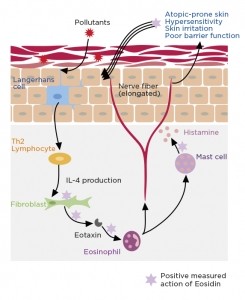Promotional Features
When skin defense overtraining leads to greater sensitivity
With climate change leading to drier and hotter air in summer and with pollution, increases in stress and skin allergies on the rise, there are more people around the world suffering from sensitive skin. This corresponds to unpleasant sensations such as itching, burning or pain. Overall, around 60 to 70% of women and 50 to 60% of men report having some degree of sensitive skin[1]. When experienced chronically, sensitive skin can lead to visible signs of discomfort such as redness. This negatively affects people’s quality of life as it impacts social functioning and psychological well-being. A recently published study[2] reported that 34.5% of adults with advanced sensitive skin limit their lifestyle and 17.7% of them avoid social interactions due to their appearance. Therefore, preventing sensitive skin, or tackling it when the first signs appear with effective skincare products is a priority for those who are affected.
Whilst researchers are yet to understand every cause of sensitive skin there is one mechanism that can explain overall skin sensitivity: epidermal barrier dysfunction and its related pathways.
A weakened barrier function occurs due to changes in the stratum corneum. When the corneocyte layer thickness decreases, or when cohesion between cells weakens, for example with the natural aging process or when people scratch itchy skin, irritant substances can penetrate more easily and deeply into the skin.
There, they are spotted by the skin defense system and initiate a chain reaction that leads to the secretion of irritant mediators: Th2 lymphocytes secrete interleukins, fibroblasts produce eotaxin to attract eosinophils, which in turn induce mast cells to release histamine. This acute reaction leads to the elimination of these irritant substances and efficiently protects the skin. But, when the same substance comes back recurrently, the defense system becomes over-trained. Even slight interactions will cause disproportionate reactions with loads of irritant molecules being secreted.
The epidermis, damaged by chronic scratching, leads to a vicious itch-scratch cycle, generating yet more histamine and preventing skin soothing.
Therefore, modulating the response to irritant substances is key to preventing dysregulation of the cutaneous sensitivity system, and gaining control of associated skin problems.
Sensitive skin control in detail: Eosidin
Following extensive studies, to better understand sensitive skin types, a key mechanism was identified. When irritants pass the stratum corneum, they activate the first line of the skin’s defense, the Langerhans cells. Once in “alert mode”, these cells stimulate Th2 lymphocytes to produce IL-4, responsible for sensitive skin pathway activation. Through a mechanism called the JAK/STAT pathway, IL-4 triggers the release of eotaxin-1 by the fibroblasts, and therefore the recruitment of eosinophils. By inhibiting the JAK/STAT pathway in fibroblasts, Eosidin, a natural active ingredient, decreases eotaxin-1 synthesis. Consequently, it inhibits eosinophil recruitment by up to 53% and then decreases a histamine release by mast cells by up to 57%. At the macro level, it consequently controls all signs of sensitive skin.
In addition, Eosidin improves the skin barrier function by significantly increasing the formation of the cornified envelope by up to 40% as well as the synthesis of all key proteins (keratin-1, involucrin, filaggrin and transglutaminase-1).
Thanks to these mechanisms, Eosidin efficiently soothes sensitive skin, as demonstrated by a clinical trial conducted on volunteers suffering from highly atopic prone skin, the idea being that the higher the degree of sensitivity, the more difficult it is to see positive results. Atopic-prone skin level (signs of advanced dryness and redness) was significantly reduced, by 18%, in 2 weeks and by 50% in 8 weeks. Volunteers evaluated their own itchiness level, on a scale of zero to ten, and after eight weeks this was significantly reduced by 68%. Sensitive skin signs were greatly alleviated with 88% of the volunteers reporting decreases in skin itchiness and a 100% reduction in skin dryness as a result of the product.
A sustainable solution for skin care formulations
Eosidin is an extract of the unripe citrus unshiu, grown in the UNESCO protected area of South Korea’s Jeju Island. To increase the size of the fruits sold as food some unripe citrus are removed from the tree before harvest. These fruits used to be discarded and up to 10% of Jeju’s production was wasted. Now, these unripe fruits are collected and used as a raw ingredient in Eosidin. This unique supply chain provides local farmers with a new opportunity to supplement their incomes and improve living standards. In addition, thanks to a dedicated production plant, everything from the harvest to the extraction process takes place on Jeju Island to develop the local economy, support local biodiversity and decrease the carbon footprint from the citrus groves to the production plant. This makes Eosidin highly sustainable, recognized by the industry as the winner of the Sustainable Beauty Award in 2018.
Eosidin is an ingredient that can be easily used to formulate skin care products to tackle sensitive skin. An example of this formulation is Sc[ai]turalist Yoga Cream, a soothing formula with an innovative texture, for skin made sensitive after exercise or sport.
For more information and to download the formula, please click here





